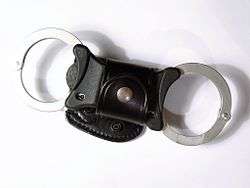Hiatt speedcuffs

Speedcuffs are a model of handcuff which were designed and produced by the now defunct UK-based Hiatt & Company. They are now produced by Safariland as the Safariland Rigid Handcuff.[1] They are characterised by their rigid grip between the two ratchet cuffs, this replacing the older type which were linked by a chain. Their rigid design and the inclusion of a grip makes them effective for gaining control over a struggling prisoner, even if only one cuff has been applied.[2][3]
Speedcuffs were standard issue for most police forces within the United Kingdom. This includes Police Community Support Officers (PCSO) of the British Transport Police (Heddlu Trafnidiaeth Prydeinig) and North Wales Police (Heddlu Gogledd Cymru)
Construction
Speedcuffs consist of two conventional ratchet handcuffs connected by a rigid metal bar, which is enclosed in a plastic grip secured with bolts. Removal of the grip offers no advantage to escape, as it is only present to facilitate the comfortable manipulation of the cuffs by the arresting officer. Weighing 390 g (13.75 oz) and with a maximum dilation of 23.2 cm (9.13 inches),[4] the speedcuffs are slightly larger than the chain-linked and hinged handcuffs previously manufactured by Hiatts, and accommodate a greater range of wrist sizes. They feature Hiatt's 'back loading' feature, which allows the ratchet to be pulled backwards for a few "clicks" through the lock casing to set the cuffs in the ideal position for quick application. The locks accept a standard handcuff key, and have a double locking facility which is activated through a small pin on the back of the cuff. The double locking facility must be depressed with a pointed object, such as the protrusion found on the top of the handcuff key; double locking prevents accidentally or knowingly tightening the cuff once it has been locked, helping to prevent paralysis or other injury.[4]
Application

The mechanism of speedcuff application is the same as other modern "swing through" handcuffs. By pressing the pivoted arm of the cuff against the wrist, the arm can be made to swing around the wrist and engage with the lock. The officer may then tighten the cuff to an appropriate position before applying the other cuff, engaging the double locking system to prevent the handcuffs tightening further.
Owing to the rigid design, speedcuffs can be applied in one of four different positions, which also apply to hinged handcuffs but not chain linked. In British police training, these positions are termed 'front stack', 'palm to palm', 'rear stack', and 'back to back'. Many forces teach two positions to their officers, but some teach all four. The 'stacked' positions are those where, once applied (assuming a standing prisoner), the handcuffs are vertical and the wrists pass through the cuffs in opposite directions, resulting in one hand on each side of the handcuffs.
'Palm to palm' is the position that results when the handcuffs are applied in front of the body, with the palms of the hands facing each other. This is generally considered to be inferior in terms of security to a front stack, in which position it is extremely difficult for a prisoner to attempt to strike any person with his hands. 'Back to back' is the position that results when the handcuffs are applied with the hands behind the body, with the backs of the hands facing each other. Rear palm to palm and front back to back are possible, but seldom used as back to back is more secure in the rear, and palm to palm is more comfortable in the front.
When these handcuffs are applied in a 'non stack' position it is more secure for the keyholes to be on the opposite side of the hands so that the prisoner cannot reach the keyhole if he or she were to have a handcuff key.
In a confrontational situation, although the ultimate intention may be to apply the handcuffs to the rear in the back-to-back position, officers are often forced to settle for the first position in which they can get both of the suspect's wrists.[5]
Media
-

Speedcuffs applied behind in the rear stack position
-

Speedcuffs applied behind the back in the back to back position
-

Speedcuffs applied in front in the palm to palm position
-

Speedcuffs applied in front stack position
Ultimate folding rigid handcuffs
As rigid handcuffs are certainly advantageous when the arresting officer has to break resistance of a violent indivual, they are rather bulky to carry. Therefore, Hiatts developed a folding rigid handcuff they called the "Ultimate" handcuff. They can be folded away when carried e.g. on a duty belt. When extracted from the holster, it snaps open to a flat profile and locks into position, becoming rigid for use.
After Hiatt ceased its business, its successor Total Control Handcuffs (TCH) continiued to produce this model as TCH 850 folding rigid handcuffs.[6]
-

closeup of TCH model 850 in a semi-folded position
-

TCH model 850 in expanded (rigid) position
-

Hiatts "Ultimate" handcuff on a duty belt
-

Hiatts "Ultimate" handcuff on a duty belt
-

Hiatts "Ultimate" handcuffs on an indvidual
References
- ↑ Model 8132 Rigid Handcuff, safariland.com.
- ↑ Handcuffwarehouse, retrieved on May 6, 2007
- ↑ TheHandcuffShop: Hiatt, Model No 2103, retrieved on May 6, 2007
- 1 2 Hiatts speedcuff rapid control system retrieved on May 6, 2007
- ↑ Gwent Police: Personal and Operational Safety Policy (including Appointments, Handcuffs, Incapacitants) from here on May 6, 2007
- ↑ "Folding Rigid Handcuffs | TOTAL CONTROL HANDCUFFS". www.tchuklimited.co.uk. Retrieved 2016-11-21.